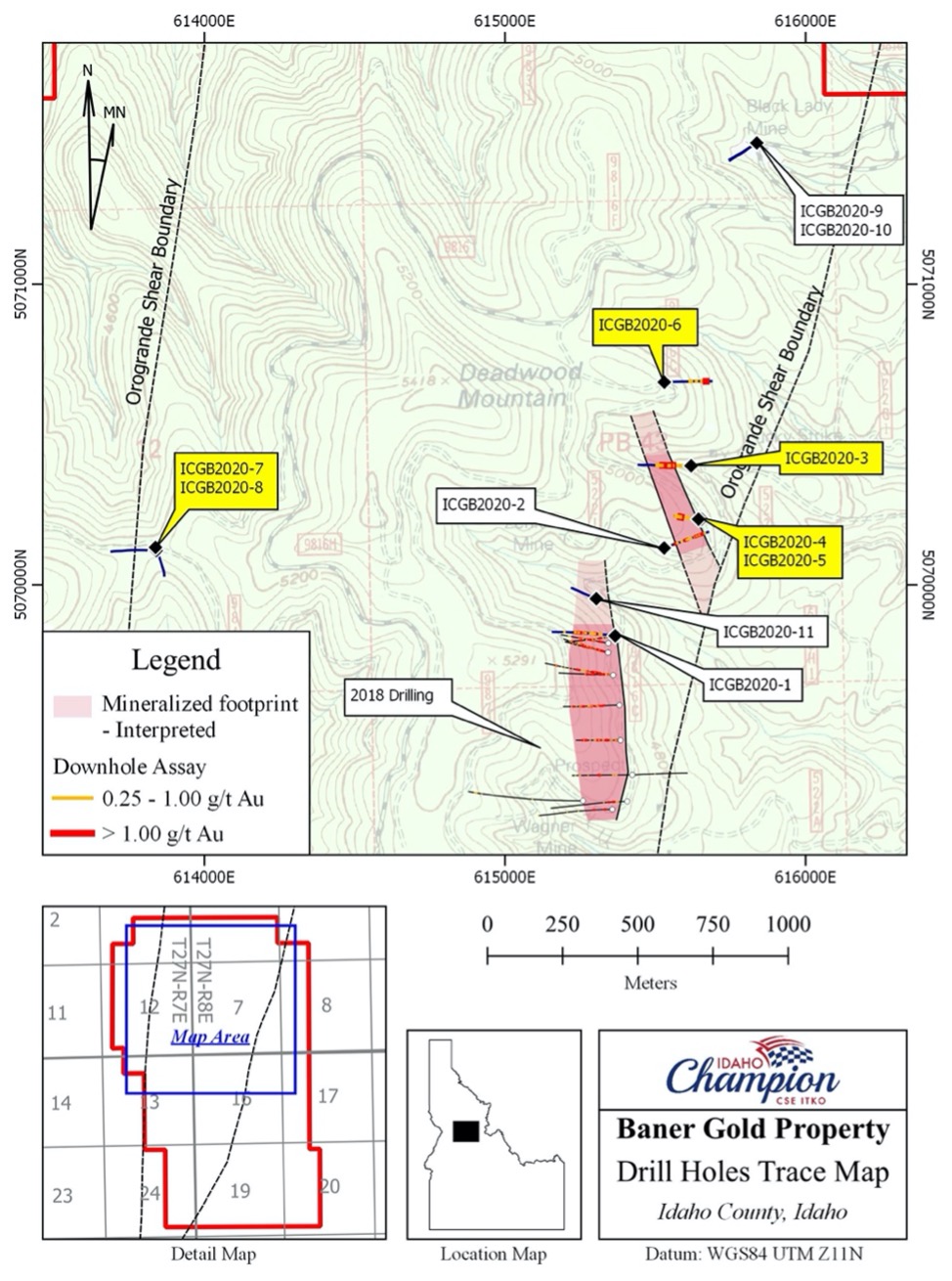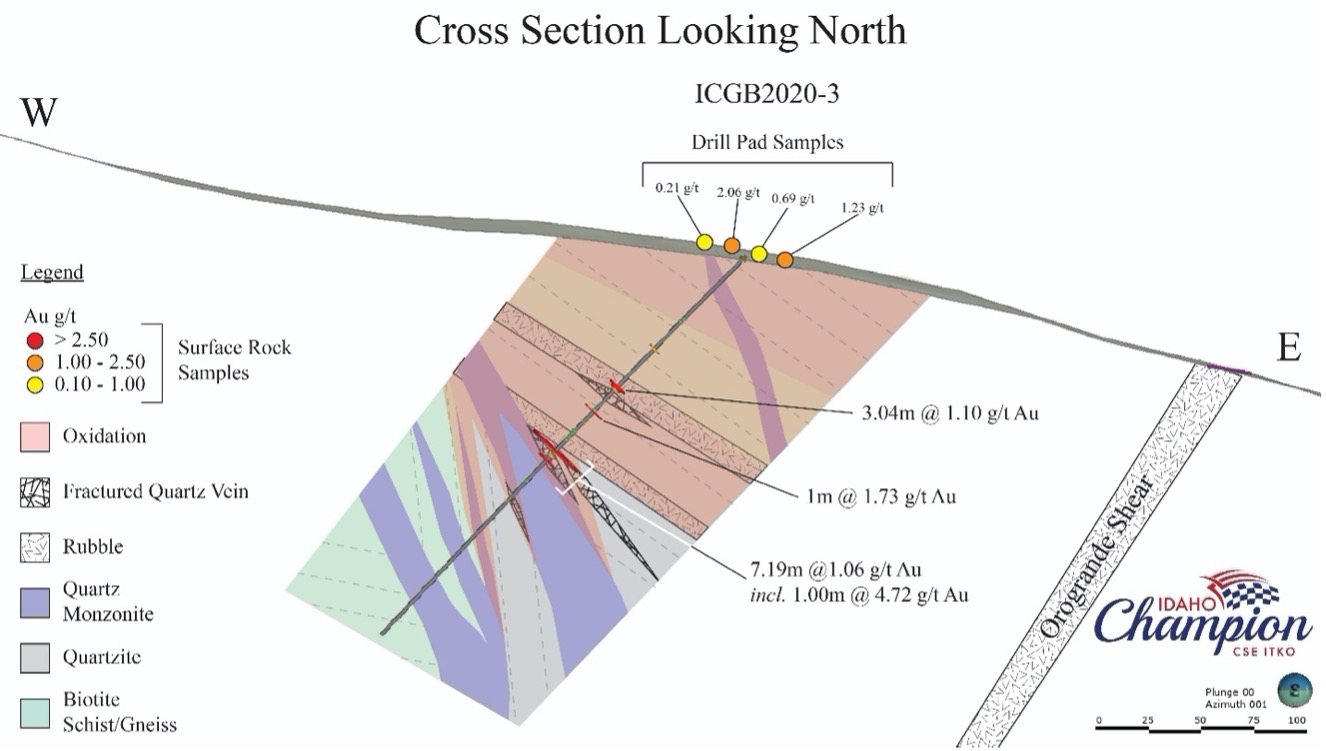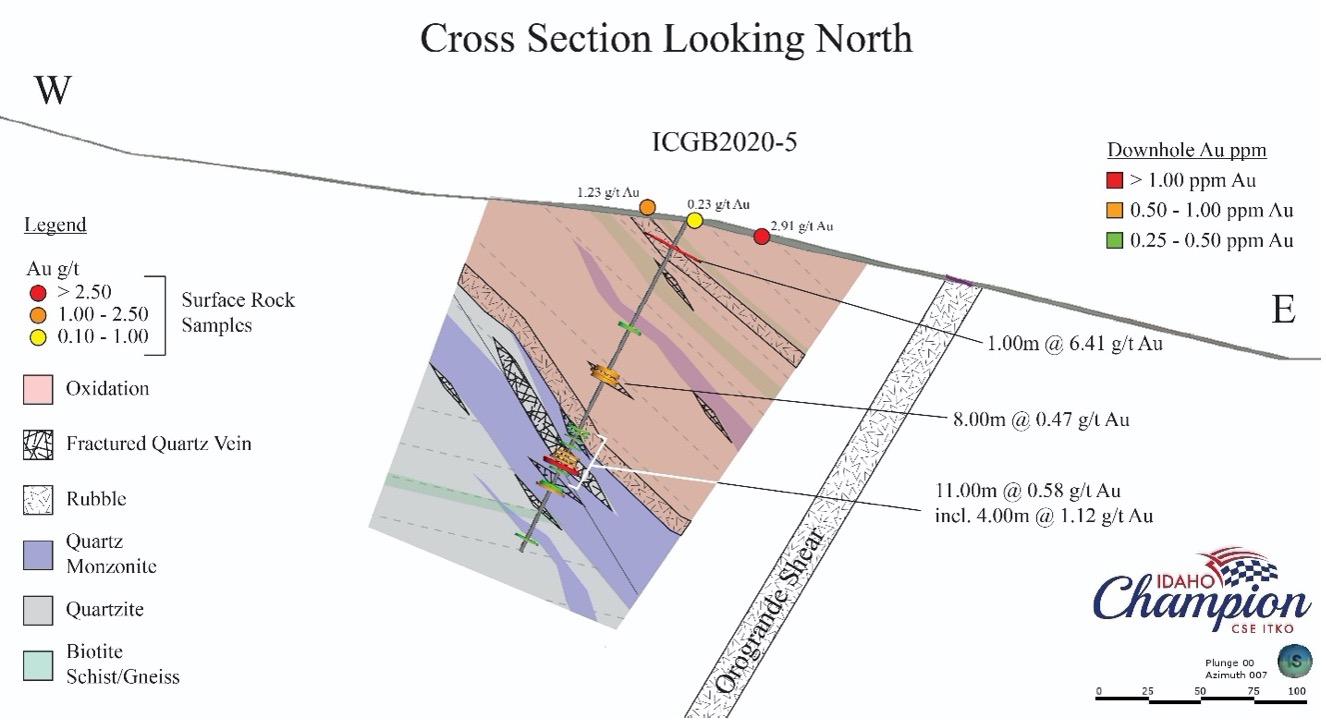Idaho Champion Gold (ITKO.V): Drilling at Baner Project Intercepts 4.50 Metres of 1.75 g/t Oxide Gold
TORONTO, ON / ACCESSWIRE / March 16, 2021 / Idaho Champion Gold Mines Canada Inc. (CSE:ITKO)(OTCQB:GLDRF)(FSE:1QB1) (“Idaho Champion” or the “Company“) is pleased to announce the next round of assay results from the 2020 diamond core drilling program at its 100% controlled Baner Gold Project (“Baner“) in the producing Elk City Mining District of Idaho.
Drilling Highlights:
- Intercepts continue to include shallow oxide-hosted gold and higher-grade quartz-sulfide vein-hosted gold mineralization at depth
- ICGB2020-3 intersected 1.06 g/t gold (“Au“) over 7.19 metres from 128.45 metres downhole, including 4.72 g/t Au over 1.00 metre at the top of the interval
- ICGB2020-5 intersected 1.75 g/t Au over 4.50 metres from 13.43 m in oxidized rock, including 6.41 g/t Au over 1.00 metre from 13.43 m
- ICGB2020-3 and ICGB2020-5 are 250m and 50m northerly step-outs from mineralized intercepts previously reported in hole ICGB2020-2, strengthening the interpretation of a separate trend which is parallel to that identified in 2018
“Our Baner drilling continues to see strong gold grades in oxides near surface. We are also now seeing good grades appearing in sulfides as we continue to extend our Baner Discovery towards the north”, commented President and CEO, Jonathan Buick. “Complementing the 2018 discovery, the 2020 drill program shows our mineralized zones are still open to the north and at depth, providing targets for further drilling in our next drill season.”
Baner Drilling Technical Summary
The 2020 drill program consisted of eleven (11) diamond drill holes totaling 2,190 metres (Figure 1). Seven core holes (ICGB2020-1 to 6, and 11) were placed centrally in the company’s claim block, targeting the northern extension of the mineralization discovered in Idaho Champion’s 2018 drill program (see press releases dated November 30, 2018). Core holes ICGB2020-7 and 8 were collared in the western area of the claim block, targeting strongly anomalous gold values in surface grab samples. Core holes ICGB2020-9 and 10 are within the northeast corner of the claim block, targeting the historical producing BL Mine.
Drill hole ICGB2020-3 was collared 275m north-northeast of hole ICGB2020-2 (Figure 1). The drill collar is located downhill from holes ICGB2020-4 and ICGB2020-5, next to an exposed adit of the historical producing Lucky Strike Mine. ICGB2020-3 was drilled along
Table 1: Summary of Significant Assay Results from 2020 Diamond Drill Hole Program Holes 3 and 7
Drill Hole | Style | From (m) | To(m) | Length (m)1 | Au (g/t) |
ICGB2020-3 | Oxide and Sulfide | 128.45 | 135.64 | 7.19 | 1.06 |
Including | |||||
Oxide and Sulfide | 128.45 | 129.45 | 1.00 | 4.72 | |
ICGB2020-4 | NSV2 | ||||
ICGB2020-5 | Oxide | 13.43 | 17.43 | 4.00 | 1.75 |
Including | |||||
Oxide | 13.43 | 14.43 | 1.00 | 6.41 | |
Oxide | 79.43 | 87.43 | 8.00 | 0.47 | |
Sulfide | 123.30 | 134.30 | 11.00 | 0.58 | |
Including | |||||
Sulfide | 127.30 | 131.30 | 4.00 | 1.12 | |
ICGB2020-6 | NSV | ||||
ICGB2020-7 | NSV | ||||
1Reported intervals are down-hole lengths and not true thickness. True thickness is estimated to be 75-90% of reported down-hole length. No gold assays are cut and intervals are calculated using a 0.1 g/t Au cutoff and a maximum of 1 metres allowable waste and a minimum 5 gram-meters gold.
2Hole ICGB2020-4 was abandoned after drilling 9.14m due to unsafe ground conditions which developed at the drill pad. The drill rig was relocated 10m along the planned azimuth and drilling was restarted as hole ICGB2020-5.
an azimuth of 270° with a plunge of -45° to a depth of 249.02m. ICGB2020-3 intersected significant mineralization at >0.1 g/t but below a 5 gram-metre threshold (Figure 2). These lower grade intervals include 6.68m of 0.25 g/t Au in oxide mineralization from surface, as well as 3.04m of 1.10 g/t Au in quartz-sulfide veins from 86.20m, 4.93m of 0.43 g/t Au in oxidized rock from 100.25m, and 7.18m of 0.28 g/t Au in oxide from 115.08m.
Drill hole ICGB2020-4 was abandoned after drilling 9.14m due to unsafe ground conditions which developed at the drill pad. The drill rig was relocated 10m along the planned azimuth and drilling was restarted as hole ICGB2020-5.
Drill hole ICGB2020-5 was drilled 150m to the northeast of hole ICGB2020-2 (Figure 1). ICGB2020-5 was drilled at an azimuth of 275° with a plunge of -60°. This hole encountered significant lengths of low-grade Au in the oxide zone, which extends to a depth of 115m (Figure 3). These intercepts include 15.2m of 0.14 g/t Au from 51.43m, and 23.87m of 0.14 g/t from 99.43m, which is contiguous with the higher-grade interval from 123.30-134.30m reported in Table 1. Hole ICGB2020-5 also intersected a zone of highly fractured sheeted quartz-sulfide veining which includes the reported interval from 127.30-131.30.
Drill hole ICGB2020-6 was drilled 275m to the North of ICGB2020-3 (Figure 1). It was drilled at an azimuth of 090° with a plunge of -60° to a depth of 333.15m, the deepest hole of the 2020 campaign. No significant shallow oxide mineralization was intersected. However, a 0.30m true thickness quartz-pyrite-galena vein was intersected at a depth of 294.2m which assayed 1.59 g/t Au.
Drill hole ICGB2020-7 was drilled near the western boundary of the Orogrande Shear Zone (Figure 1). It was drilled at an azimuth of 270° with a plunge of -45°. ICGB2020-7 encountered extensively sheared and fractured Belt Supergroup metamorphosed sedimentary rocks and quartz monzonite dikes, suggesting the hole intersected the major shear structure. This hole returned no significant gold mineralization.

Figure 1. Locations of 2020 diamond drill holes (blue lines) in the context of the Orogrande Shear Zone and 2018 drilling (black lines). Yellow text annotations indicate the locations of the drill holes reported in this news release.
Mineralization at Baner is found to occur in two styles: shallow oxide mineralization and deeper quartz-sulfide veins and stringers (see Figures 2 and 3). Shallow oxide mineralization is dominantly hosted within strongly fractured and brecciated quartzite occurring as an oxide overprint on pre-existing quartz-sulfide vein mineralization. Deeper quartz-sulfide vein mineralization is localized by brittle structures, which are commonly found at the contact between metamorphosed sedimentary rocks of the Belt Supergroup with quartz monzonite igneous dikes. The oxide-sulfide transition is usually associated with highly fractured rock, with a basal layer of rock fragments cemented by iron oxide-stained clay.
Multi-element analyses of drill core indicate that arsenic, mercury, and antimony are good geochemical indicators of gold mineralization. Enrichment of lead, zinc, and weak copper is also associated with elevated gold content.

Figure 2. Interpretive geological cross section showing Au intercepts from drillhole ICGB2020-3, plotted on interpreted geology. Gold was intersected in both oxide zones, and at the oxide-sulfide transition. The size of red disks corresponds to Au grade. Rock chip samples were collected from drill road cuts, and from outcrop exposed while constructing the drill pad.

Figure 3. Interpretive geological cross section showing Au intercepts from drillhole ICGB2020-5, plotted on interpreted geology. Gold was intersected in oxide zones and quartz-sulfide veins. The size of red, orange, and green disks are logarithmically scaled to correspond to Au grade. Rock chip samples were collected from drill road cuts and from bedrock exposed during construction of access road and drill pad.
QA/QC Program
Idaho Champion Gold adheres to a regimented drill core handling and processing procedure. Core from the drill rig(s) is logged for lithology, mineralization, structure, alteration, and veining. During the logging process samples up to 1.5m core length are delineated by company geologists. Core is then photographed and sawn in half. Following sawing, individual samples are extracted from core boxes and inserted into individual sacks with a unique waterproof sample number tag and sealed. The remaining half-core is left in core boxes for storage. Sacks containing samples are kept securely indoors on site until they are transported to the assay lab.
Quality control (QC) samples are inserted into the sample stream such that there is one QC sample for every ten drill core samples. These QC samples consist of certified standards (known metallic content) and blanks (known barren of metals). Two styles of blank material were used: a coarse blank and a pulverized blank. QC sample insertions alternate between standard and blank. Additional core duplicates were inserted into the sample stream where necessitated by geology, i.e. core samples containing wide veins were sawn in half, then one half sawn into quarters and submitted as two separate samples.
Samples were delivered to American Assay Labs (AAL) in Sparks, NV, with a small number of samples being analyzed at American Analytical Services (AAS) in Osburn, Idaho. Sample prep was conducted at AAS. AAL and AAS conform to ISO 17025 requirements. All drill samples and coarse blanks are crushed to 70% passing 2mm at the sample prep lab, and 1 kg material is split and pulverized to 85% passing 75 microns. All samples are processed by 30-gram fire assay- inductively coupled plasma – emission spectrometry (ICP-ES). Samples are additionally analyzed for 36 or 47 element analysis by ICP-ES and/or inductively coupled plasma – mass spectrometry (ICP-MS). Samples containing Au or Ag above maximum reporting limits by ICP-ES analysis are automatically re-analyzed by fire assay with a gravimetric finish.
All drill intervals included in Table 1 in this release are calculated using a 0.10 g/t gold cut-off grade and a maximum of 1-metre consecutive waste and a minimum 5 gram-metres of gold.





























